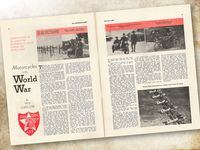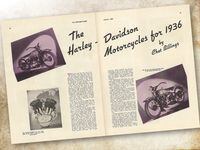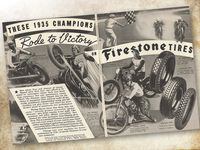Observations of an American Motorcycle Racer During the World War
by Fred Ludlow
Keep in mind, this article was written before the advent of the second war, the war "To End All Wars" explains the title. Our author was Fred Ludlow from Pasadena, CA who was an accomplished racer in his day and like many men his age, volunteered to fight the Huns in WWI and did this astride a motorcycle.
Fred along with a small group of Angelenos, started drilling at a place called “Mines Field” which was later renamed Los Angeles International Airport or “LAX”. The decision to use this field was based on its rough and varied surfaces that included ditches and plowed fields which was what the group figured would be the most likely terrain faced in France. That proved to not really be the case.
Before Fred and the rest of the 322nd Signal Group was called up, they outfitted 12 motorcycles for the fields “as they saw fit”. No motorcycle brands were mentioned in this article but the fleet consisted of 12 machines. 9 were outfitted with sidecars and 3 were solo machines. When the group got to France and went to “collect” their customized motorbikes they were very disappointed. The Captain in Dijon who issued the bikes gave them “Several of the worst junks I had ever seen.”
Fortunately, the 322nd was a mechanically inclined group. This was not the case with other units that the 322nd encountered on the Western Front. They often times fixed the machines of other units for them out in the field. This skillset was critical as there was no resupply in France for anything. Broken forks were mended with U-bolts and one of the most used repair materials on all parts of the motorcycles was barbed wire which was in ready supply everywhere.
Throughout the war and for a short time after its conclusion Ludlow and company had to creatively source parts, a motor, and even “one snappy-looking new outfit [motorcycle] which belonged to some colonel” to keep the fleet running. When the machines were turned in, they had seen their whole useful life - and then some. A few of them had to be pushed back to the depot to be turned in.
Ludlow is certain the the services he and his comrades in the signal corps offered made a difference. He was quite amazed at what they managed to do with a pair of pliers, a screwdriver and a lot of barbed wire.
New motors for 1936, more features and the same prices!
by Chet Billings
This is an interesting article with a focus on the "experiments" of Harley-Davidson in 1935 which brought about new motor designs and model upgrades.
“This year more than any time since the depression and subsequent recovery started, engineering eyes have been turned toward mechanical performances in our sports, in commerce, and police work.”
First, the motors. Fins were lengthened and an extra bolt was added to the cylinders to “offer a better seal between the cylinder and the head”. The combustion chambers were redesigned to meet new standards in fuel to make the engines run more smoothly, increase efficiency.
45 in models
* RL - Standard Compression
* RLD - High Compression for "fast touring"
* RLDR - Extra Fast "super sports" model recommended for Class C competition, road racing, etc.
74 in Models
* VL - Standard Compression - capable of 80-85 mph
* VLD - High Compression "job" [The term "job" appears throughout the entire Motorcyclist January 1936 issue in reference to motorcycles.] that will "tickle" 100 mph
80 in Big Twin - "has long been a part of the Harley-Davidson family and this year is being actively featured as part of their line."
The article is quite technical about what was replaced, adjusted and upgraded for 1936 yet light on model specific details. This year the design changes across model lines included:
- Ammeter - Dials supported, Pointer material strengthened and dampers added
- Clutch Adjustment Cover - Chrome cover with two screws over the clutch adjustment opening in the front chain guard. "This serves the double purpose of keeping out dirt and improving the appearance."
- Transmission Oil Retainers - A combination of leather and oil-resistant rubber with a steel washer
- Sidecar Body Design - Long speedy lines and stainless steel moulding t give it a decidedly car car designed (in 1936) reflection
- Color Blending - new transfer methods and an eye on design decreases the discordance of color and lines Five color combinations for 1936:
- Sherwood green and silver
- Teak red and black
- dusk gray and royal buff (not sure what "buff" is?)
- Venetian blue and Croydon cream
- Maroon and Nile blue
- Chain Guard - on the 74 in the chain guard was lengthened to keep everything cleaner
- Brake Shoes - increased thickness for longer life and better feel
Servi-Car
All changes seen on the 45 for 1936 will carry over into the Servi-Car including the full list of 1936 color combinations. The rims will be enamelled and the tow bar "is also fitted with auxiliary cable to comply with the hitch laws of numerous states". Trunk locks have been replaced with a chrome plated spring latch. Something we're not sure of is that the Servi-Car got a more efficient "Snubber". (Could this be a small person who puts on airs when confronted about model features and when in the presence of machines from other manufacturers… unlikely.)
Pricing
Most models retained their 1935 prices and in two instances, the price has dropped even though there were a slew of improvements for the model year. The 80 Twin dropped by 7 dollars. The 45 had a few slight adjustments. The RLD Twin 45 dropped by 10 dollars list and the RLDR 45 Twin decrease of 2 dollars. Production had started early and unlike past years, dealers would have models at the beginning of the year and not color posters as they had in the recent past
Riding Impressions
These were pretty light in the article but here is a summation:
The 45 “It was all there, in higher degree of perfection than any year before - balance, ready response to throttle, easy riding on rougher roads and smoothness at sustained speeds.”
The 74 “was tried. Of course it had more steam. It seemed to live up to all of the other qualifications set for it. Then it was just a case of changing from number eight shoes to tens because nines felt so good. The 74 put a little quiver in the throttle which was not satisfied until we bestrode an 80.”










/cloudfront-us-east-1.images.arcpublishing.com/octane/PU6AAYA5TKZFPKTRODNMRDWTUA.jpg)






/cloudfront-us-east-1.images.arcpublishing.com/octane/FZXHNOQRNVA3BIDWAF46TSX6I4.jpg)
/cloudfront-us-east-1.images.arcpublishing.com/octane/JRSFLB2645FVNOQAZCKC5LNJY4.jpg)
/cloudfront-us-east-1.images.arcpublishing.com/octane/ITNLTIU5QZARHO733XP4EBTNVE.jpg)
/cloudfront-us-east-1.images.arcpublishing.com/octane/VZZXJQ6U3FESFPZCBVXKFSUG4A.jpg)
/cloudfront-us-east-1.images.arcpublishing.com/octane/QCZEPHQAMRHZPLHTDJBIJVWL3M.jpg)
/cloudfront-us-east-1.images.arcpublishing.com/octane/HXOUJXQWA5HBHGRO3EMJIGFMVI.jpg)

/cloudfront-us-east-1.images.arcpublishing.com/octane/3TIWWRV4JBBOLDVGRYECVVTA7Y.jpg)
/cloudfront-us-east-1.images.arcpublishing.com/octane/KIX5O23D5NAIBGFXBN3327DKZU.jpg)
/cloudfront-us-east-1.images.arcpublishing.com/octane/7GJYDUIPXRGMTMQKN6ONYOLBOU.jpg)
/cloudfront-us-east-1.images.arcpublishing.com/octane/MUQLOVLL2ZDGFH25ILABNBXKTI.jpg)
/cloudfront-us-east-1.images.arcpublishing.com/octane/TNOU5DNE2BC57MFPMGN2EIDXAM.jpg)
/cloudfront-us-east-1.images.arcpublishing.com/octane/GTCXACQGJ5HAPDTGWUQKDEH44E.jpg)
/cloudfront-us-east-1.images.arcpublishing.com/octane/S35YGSEMEZB4BLTDJTSZPF4GLA.jpg)
/cloudfront-us-east-1.images.arcpublishing.com/octane/5UOT6HPX2JFMRJAX6EH45AR4MQ.jpg)
/cloudfront-us-east-1.images.arcpublishing.com/octane/OKWOJWAKP5EP3OACCRRWPCIX2Q.jpg)
/cloudfront-us-east-1.images.arcpublishing.com/octane/2WF3SCE3NFBQXLDNJM7KMXA45E.jpg)
/cloudfront-us-east-1.images.arcpublishing.com/octane/G4MG6OUCJNBSHIS2MVVOTPX65E.jpg)
/cloudfront-us-east-1.images.arcpublishing.com/octane/IIGGWFOTOJGB7DB6DGBXCCMTDY.jpg)
/cloudfront-us-east-1.images.arcpublishing.com/octane/QSTCM6AVEZA5JJBUXNIQ3DSOF4.jpg)
/cloudfront-us-east-1.images.arcpublishing.com/octane/U4I7G625B5DMLF2DVIJDFZVV6M.jpg)
/cloudfront-us-east-1.images.arcpublishing.com/octane/B6XD6LS6IVCQPIU6HXDJSM3FHY.jpg)
/cloudfront-us-east-1.images.arcpublishing.com/octane/ICL63FEDDRDTTMINYICCEYGMDA.jpg)
/cloudfront-us-east-1.images.arcpublishing.com/octane/FCGZHQXRBZFLBAPC5SDIQLVF4I.jpg)